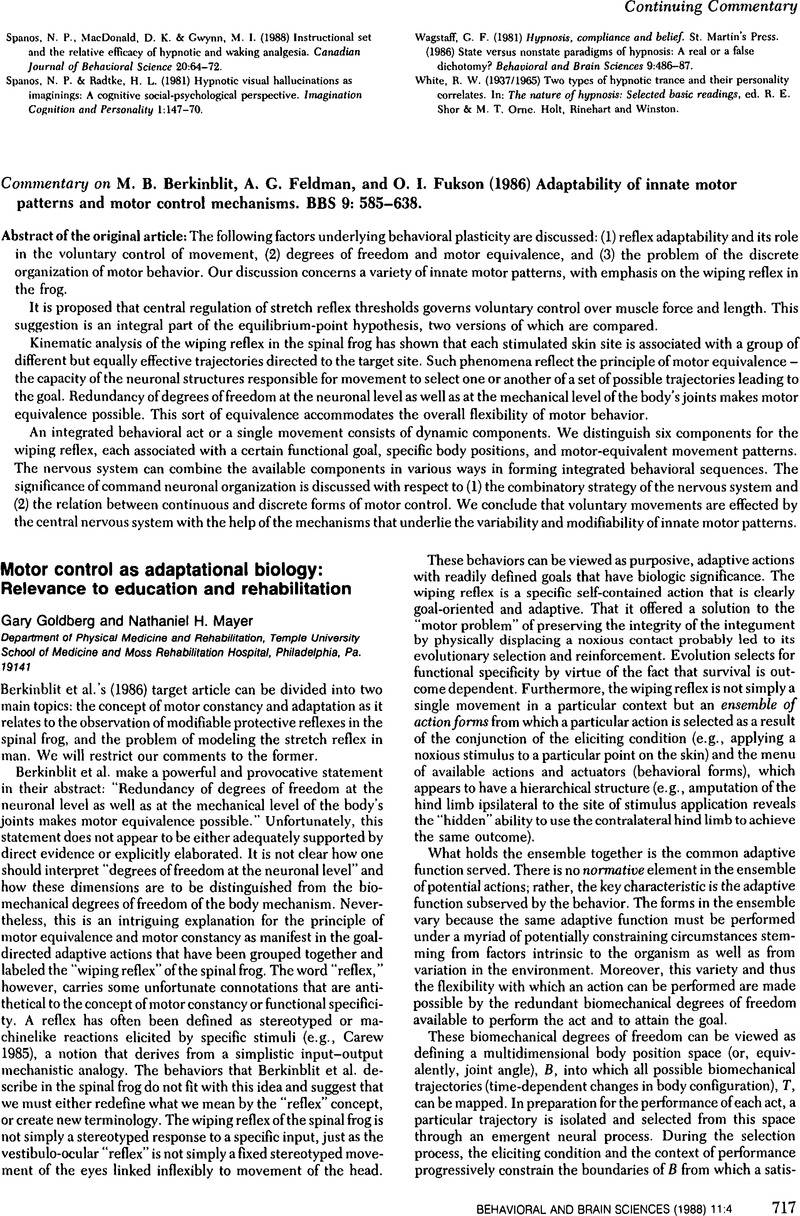No CrossRef data available.
Article contents
The organization and optimization of movement
Review products
Commentary onBerkinblitM. B., FeldmanA. G., and FuksonO. I. (1986) Adaptability of innate motor patterns and motor control mechanisms. BBS 9: 585–638.
Published online by Cambridge University Press: 04 February 2010
Abstract
An abstract is not available for this content so a preview has been provided. Please use the Get access link above for information on how to access this content.

Information
- Type
- Author's Response
- Information
- Copyright
- Copyright © Cambridge University Press 1988
References
Berkinblit, M. B., Feldman, A. G. & Fukson, O. I. (1986) Adaptability of innate motor patterns and motor control mechanisms. Behavioral and Brain Sciences 9:585–638.Google Scholar
Berkinblit, M. B., Feldman, A. G. & Fukson, O. I. (1986r) In search of the theoretical basis of motor control. Behavioral and Brain Sciences 9:626–31.Google Scholar
Berkinblit, M. B., Gelfand, I. M. & Feldman, A. G. (1986) A model for the control of multi-joint movements. Biofizika 31:728–38.Google Scholar
Bernstein, N. H. (1984) Human motor actions: Bernstein re-assessed, ed. Whiting, H. T. A.. North-Holland.Google Scholar
Carew, T. J. (1985) The control of reflex action. In: Principles of neural science, 2d ed., ed. Kandel, E. R. & Schwartz, J. H.. Elsevier.Google Scholar
Davis, W. E. & Sinning, W. E. (1987) Muscle stiffiness in Down syndrome and other mentally handicapped subjects: A research note. Journal of Motor Behavior 19:130–44.CrossRefGoogle Scholar
Edelman, G. M. (1987) Neural Darwinism. The theory of neuronal group selection. Basic Books.Google Scholar
Flash, T. (1987) The control of hand equilibrium trajectories in multi-joint arm movements. Biological Cybernetics 57:257–74.Google Scholar
Gelfand, I. M. & Tsetlin, M. L. (1967) Mathematical modeling of mechanisms of the central nervous system. In: Models of the structural-functional organization of certain biological systems, ed. Gelfand, I. M., Curfinkel, V. S., Fomin, S. V. & Tsetlin, M. L.. MIT Press.Google Scholar
Hasan, Z. (1986) Do subprograms for movement always seek equilibrium? Behavioral and Brain Sciences 9:609–10.Google Scholar
Hogan, N. (1984) An organizing principle for a class of voluntary movements. Journal of Neuroscience 4:2745–54.Google Scholar
Kelso, J. A. S. & Kay, B. A. (1986) Information and control: A macroscopic analysis of perception-action coupling. In: Tutorials in perception and action, ed. Heuer, H. & Sanders, A. F.. North-Holland.Google Scholar
Mishkin, M. & Appenzeller, T. (1987) The anatomy of memory. Scientific American 256:30–41.Google Scholar
Nashner, L. M. & McCollum, G. (1985) The organization of human postural movements: A formal basis and experimental synthesis. Behavioral and Brain Sciences 8:135–72.CrossRefGoogle Scholar
Prosser, C. L. (1986) Adaptational biology: From molecules to organisms. Wiley Interscience.Google Scholar
Reed, E. S. (1984) From action Gestalts to direct action. In: Human motor actions: Bernstein re-assessed, ed. Whiting, H. T. A.. North-Holland.Google Scholar

